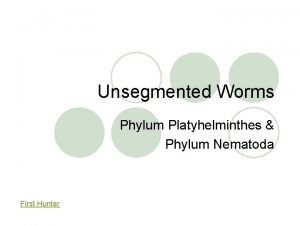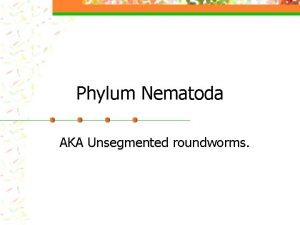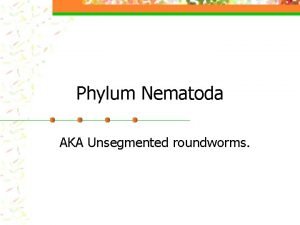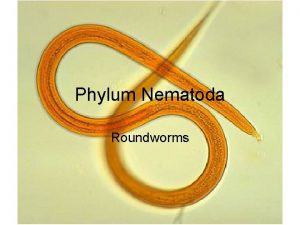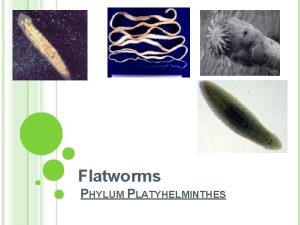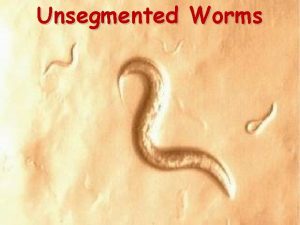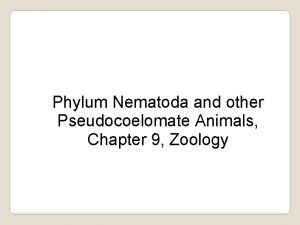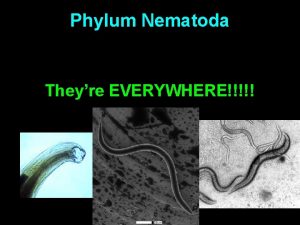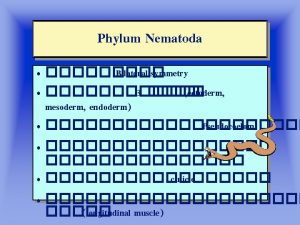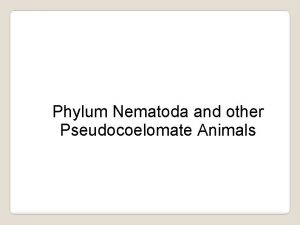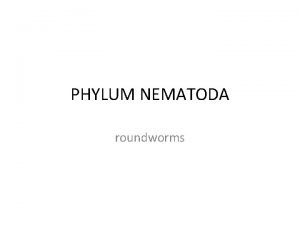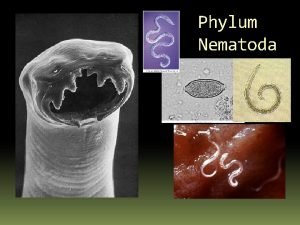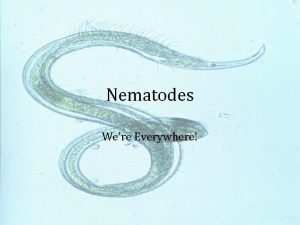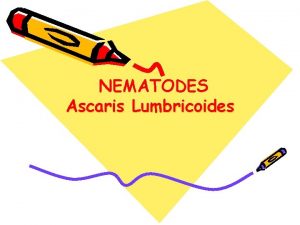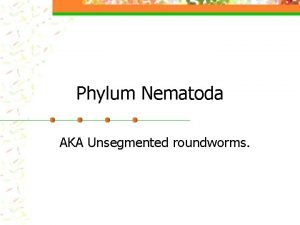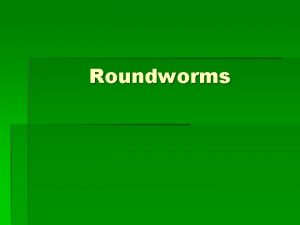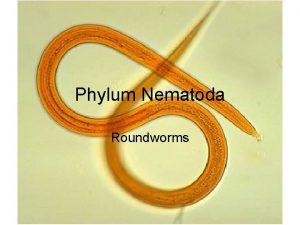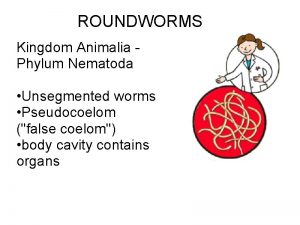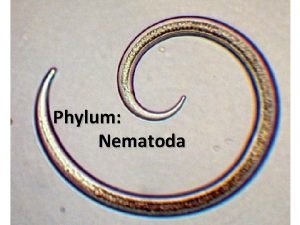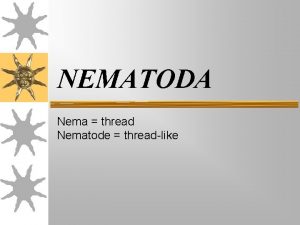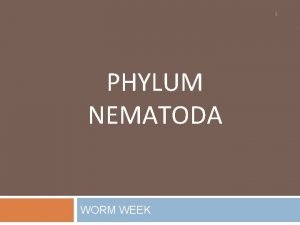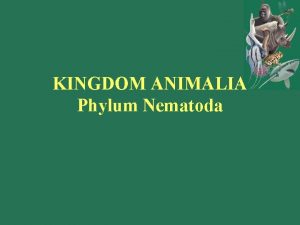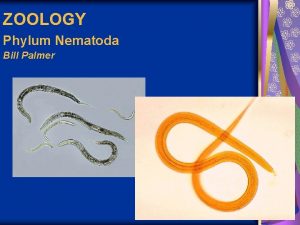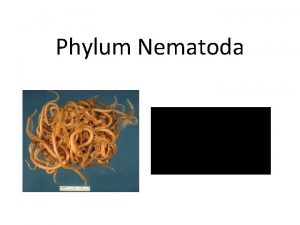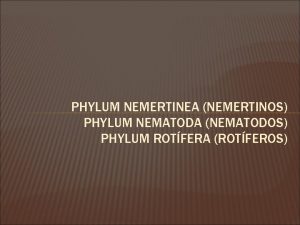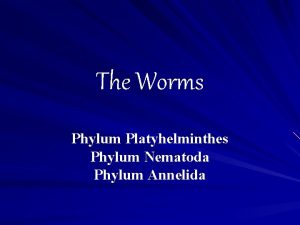Phylum Nematoda AKA Unsegmented roundworms Nematodes n Advancements




















- Slides: 20

Phylum Nematoda AKA Unsegmented roundworms.

Nematodes n Advancements over flatworms: n n Has a two-hole digestive tract. Not as advanced as “higher” worms, such as earthworms because: n They lack body segmentation.

Nematodes, cont’d n n Unsegmented roundworms are classified into about 16, 000 species, but the actual number of nematode species could be as high as 500, 000. Nematode facts: n n n Colorless Range in length from microscopic to several meters long. May be free-living or parasitic.

Nematode Habitat n Nematodes live in: n n Parasitic nematodes live within a host Free-living nematodes live in marine, freshwater, or damp soil environments.

The Nematode lifestyles n Nematodes generally live one of two types of lifestyles: free-living or parastic.

Free-living Lifestyle n Eating habits: n n n Herbivores – eat plants Carnivores – eat animals Omnivores – eat both plants & animals Saprophagous -Eat dead organic matter (from animals only), Yummy Free-living; and have the eating habits mentioned on the previous slide. n The free-living nematodes are important because they add organic matter to the soil and putting holes in the soil to better allow water movement through the soil.

Parasitic Lifestyle n Parasitic – feed off of a host. n n These worms feed of the blood or tissue fluids of their hosts. We will learn about four types of parastic nematodes: filarial worms, hookworms, trichina worms, and ascaris worms. n Interesting tidbits: n n The filarial worms cause the disease elephantitis, pictured to the left. Trichina worms cause trichinosis – the horrid disease contracted from eating undercooked pig products.

Nematode Body Plan n Nematodes have three cell layers: n n n Ectoderm – outer tissue layer (epidermis) Mesoderm – middle tissue layer (muscle) Endoderm – innermost tissue layer (body cavity) They are known as psuedocoelomates because they have an internal cavity that is not lined with peritoneum – therefore it is not a “true” coelom. They are bilaterally symmetrical – as is every organism we study from here on out.

Nematode Epidermis n n n The outside of the nematode is made up of a tough, flexible, noncellular layer known as the cuticle. The cuticle is secreted by epidermal cells. It functions to: n n Resist penetration – in free-living. Resist enzymatic digestion – in parasitic. Maintains internal hydrostatic pressure. The cuticle usually molts 4 times during maturation.

Nematode Digestive System One way digestive system; remember this means that food goes in one way and out another. Just like us. n The digestive tract is a linear progression, as shown below: n mouth pharynx intestines rectum anus n Food is pushed through this system by hydrostatic pressure.

Nematode Musculature n The nematode body wall has only longitudinal muscles. n n Remember longitudinal means lengthwise, so they only run from the anterior to the posterior end of the worm. These muscles are used for movement. When these muscles contract it causes the thrashing movements from head to tail. They lack circular muscles so they cannot crawl as we saw the leech do on dry surfaces.

Excretory System Aquatic species have ventral glands (called renettes) posterior to the pharynx that absorb waste from the pseudocoelom and empties the waste through the excretory pore. n Parasitic nematodes have a more advanced excretory system. n

Parasitic Excretory System n n n Their system is known as a tubular system that develops from the renette system of the free-living worms. The renettes unite to form two large canals, known as the excretory canals that open to the outside by an excretory pore which is located by the head. A little odd to excrete wastes near your head, eh?

Excretory System Diagram

Reproductive System n Most nematodes are: n n Dioecious: two different types of reproductive cells; ex. sperm & egg. Dimorphic: two different sexes; ex. male and female. As you might guess, they reproduce sexually. The males are slightly smaller than the females. Why?

Female Reproductive System Consists of a pair of ovaries attached to an oviduct that has a swollen proximal end that forms a seminal receptacle. n Each oviduct becomes a tubular uterus, and the two uteri come together to form a vagina that opens to the outside through a genital pore. n

Male Reproductive System n Most male nematodes have only a single testis attached to the vas deferens which expands into a seminal vesicle which connects to the cloaca. n What are all these things? n n Vas deferens – aka sperm duct, releases sperm Seminal vesicle – stores sperm cells Cloaca – hole that sperm is ejected from They also have a flap of tissue called the bursa that aids in the transfer of sperm to the female genital pore.

Reproductive System Diagram

Brief Parasitic Nematode Info. n Pinworms n n Hookworms n n Most common roundworm in the U. S. Adults reside in the large intestine. Enter humans by being eaten. Found in the southern U. S. Adults live in the small intestine of humans. Enter host through the skin, usually between the toes. That makes you want to walk around barefoot, doesn’t it? Trichina n n n Live in humans & other omnivores (like piggys) Adults live in the small intestine of it’s host; larvae encyst in the stomach and skeletal tissue (ouch!) Enter host by being eaten.

Nematode Nervous System n Nematodes have two nerve cords in their bodies. n n n Ventral nerve cord – runs along the “belly. ” Dorsal nerve cord – runs along the “back. ” They have a central nervous system consisting of a circular brain. The nervous system allows the nematode to detect its environment and react to it. Aquatic nematodes have a pair of ocelli (eyes).
 Nematoda
Nematoda Nematoda
Nematoda Unsegmented roundworms
Unsegmented roundworms Roundworms phylum
Roundworms phylum Simplest bilateral animals
Simplest bilateral animals Hookworms
Hookworms Anatomy of nematodes
Anatomy of nematodes Phylum nematoda anatomy
Phylum nematoda anatomy Tripoblastic
Tripoblastic Class of phylum nematoda
Class of phylum nematoda Asexual reproduction of flatworm
Asexual reproduction of flatworm Are mollusca bilateral symmetry
Are mollusca bilateral symmetry Roundworm phylum name
Roundworm phylum name Nematoda bilateral symmetry
Nematoda bilateral symmetry Nematoda simetria
Nematoda simetria Advancements in solar energy
Advancements in solar energy Interesting facts about nematoda
Interesting facts about nematoda Platyhelminthes vs nematoda
Platyhelminthes vs nematoda Nematoda
Nematoda Excretory system of nematodes
Excretory system of nematodes Morphology of nematodes
Morphology of nematodes
